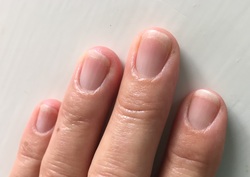|
Wellness comes understanding and listening to what your body is telling you. One of the ways your body can talk to you is through your fingernails. Please take a moment to observe your nails and see how your body is doing. Often these self-tests can save you a lot of time and money. Literally wellness is at the tip of your fingers.
Any change in the look, shape, or color of our fingernails can indicate a disorder or a disease somewhere in our body. Look at your nails then read on. If you see something strange or different with your nails start researching. This could be a piece of your wellness puzzle. Various issues your fingernails can tell you.
References: [1] National Institutes of Health (2015). Clubbing of the fingers or toes. http://www.nlm.nih.gov/medlineplus/ency/article/003282.htm [2] "New Health Guide." White Spots on Nails. (2014) http://www.newhealthguide.org/White-Spots-On-Nails.html [3] National Institutes of Health (2015). Capillary nail refill test. http://www.nlm.nih.gov/medlineplus/ency/article/003394.htm [4] "Brittle Nails: Check Your Symptoms and Signs." Brittle Nails: Check Your Symptoms and Signs. (2015) http://www.medicinenet.com/brittle_nails/symptoms.htm [5] National Institutes of Health (2015). Nail abnormalities. http://www.nlm.nih.gov/medlineplus/ency/article/003247.htm [6] "Pictures of What Your Nails Say About Your Health: Ridges, Spots, Lines, Bumps, and More." WebMD. (2014) http://www.webmd.com/skin-problems-and-treatments/ss/slideshow-nails-and-health [7] National Institutes of Health (2015). Fungal nail infection. http://www.nlm.nih.gov/medlineplus/ency/article/001330.htm
0 Comments
Leave a Reply. |
CategoriesBy: Candace RayCandace Ray, mom, Lyme advocate, healthy living motivator who just wants to have fun and enjoy what life has to offer! Archives
February 2020
|


 RSS Feed
RSS Feed